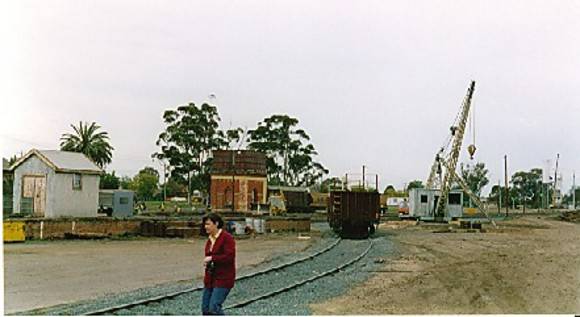| Back to search results » | Back to search page » |
|
Mount Alexander and Murray River Rail way Line
Other NamesMelbourne - Bendigo - Echuca Railway Line , Melbourne-Echuca Railway Line LocationECHUCA VIC 3564 - Property No B5323
File NumberB5323LevelState |
|
Statement of Significance
Opened in five stages from 10/2/59 to 19/9/64, this railway, known initially as the Melbourne, Mt Alexander and Murray River Railway by its promoters, and later, during construction, as the Melbourne and River Murray railway, was the largest of the Colony's first two trunk lines.
It is significant for its close adoption of English engineering and architectural standards and survives as a monument to the work of engineers-in-chief George Christian Darbyshire (1856-1860) and more particularly Thomas Higinbotham (1860-1878).
The diversity in the design and choice of construction materials of buildings and structures is greater than any of the other trunk lines, the level of integrity of the whole line being higher. Materials selection, ranging from bluestone and granite to monochrome and bichrome brickwork was influecned not only by the natural resources of the localities through which the line passed, but also by forms of architectural expression commonly accepted at the time.
Thus, the use of bi-chrome brickwork occurs in the central goldfields where its use was generally popular. The range of bridge and viaduct designs includes girder bridges and round, three centred and segmentally arched openings, whilst the scale of the viaducts compare with the Geelong-Ballarat main trunk line.
This railway also recalls the work of the major contractors for the line and structures and provides evidence of their capabilities and of the role of the railway in developing the Colony's engineering and building skills.
Apart from the line contractors, other firms directly involved were J Shirelaw and Co (sleepers), R Fulton, Langlands Brothers and Co, William Crossley (water supply), B Moreland. Langlands Brothers and Co (platelayers lorries), E Chambers (iron pins, traversers), Miller and Macquinstan (luggage vans and steam engines) and various contractors for building works.
The line is important also an an expression of the importance in capturing the Murray River and Riverina trade for the Port of Melbourne whilst it also recalls the significance of the Castlemaine and Bendigo goldfields during the 1860s.
The route of the line recalls the lobbying of landowners and townspeople to have the railway diverted in their interests, and the stonework is an important expression of the work of local and imported masons. It recalls the tough line adopted by the major contractors, Messrs Cornish and Bruce on wages and working conditions and their decision to import 400 German masons to compete with local members of the Stonemason's Society. With a labour force of more than 6,000 men, the Echuca railway remains as the Colony's largest single endeavour of its time.
Addition to Citation for Melbourne to Echuch Railway Line: 01/10/1990 Double Head Rail The surviving lengths of double head rail with chairs on this railway compare with one surviving similar remnant on the Geelong to Ballarat railway and are representative of premanent way construction techniques applied exclusively to the two trunk railways of the 1860's. In this respect they are rare survivors and may be unique at the national level and of technical importace at the international level to the extent that they enhance contemporary understanding of early railway building technology. Surviving lengths of chaired double head rail survive at Kyneton, Ravenswood and Bendigo on this railway and include a number of different types of cast iron intermediate and joint chairs with hardwood keys and metal pins. The Ravenswood siding is of special significance for the diversity of chair types and for the sequence of chairs recalling rail lengths known to be associated with construction of the line in 1862. The Bendigo goods shed siding is important for its association with the goods shed itself and also to the extent that its protected location ensures its continued existence, in situ, as opposed to the other remaining installations which are subject to deterioration through lack of use.
Classified 30/9/82
See also Files associated with Melbourne-Echuca Railway Line, Numbers B1787, B2644; Sunbury Viaducts, Clarkfield, B5319 Riddell' s Creek, Gisborne, Macedon, Woodend, B4912 Carlsruhe, B3847 Kyneton, B1288 and B289 Malmsbury, B2993 and B3931 Taradale, B3848 Elphinstone, B3849 Castlemaine, B2659 Harcourt, Ravenswood, Kangaroo Flat, B3215 and B317 Bendigo, Goornong, B5767 and B4913 Elmore, B5746 Rochester, B3173, B3554 and B2601 Echuca.
Group
Transport - Rail
Category
Railway




